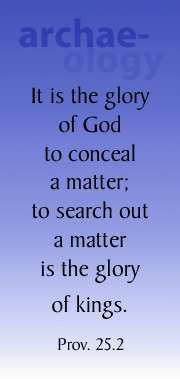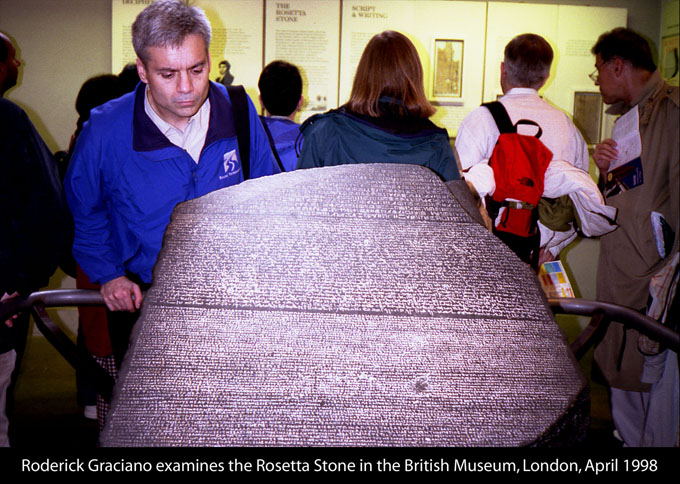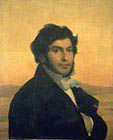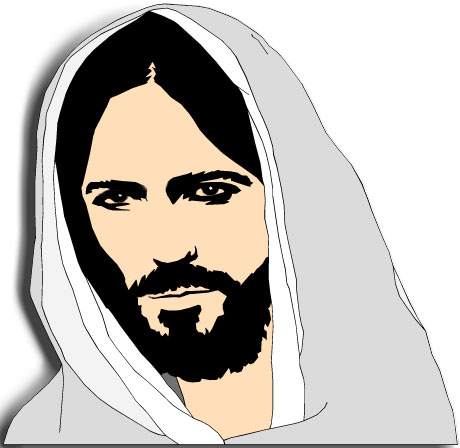
|

The Rosetta Stone and Jesus
of Nazareth
Before the Rosetta Stone came to
light, no one in modern times could read Egyptian hieroglyphs.
Napoleon’s
French soldiers discovered the stone in El-Rashid (Rosetta), Egypt,
in 1799. It is a  large fragment of a stela, a sort
of tombstone-shaped
slab, which was once placed in a temple of Ptolemy. It bears a lengthy
inscription written in three versions: in hieroglyphic, in demotic (another
Egyptian script), and in Greek. It was the parallel Greek version of
the inscription which allowed scholars, most notably Jean François Champollion (1790-1832) shown
at left, to correlate a known language with the Egyptian text, and
thereby crack the code of Egyptian hieroglyphics. The French ceded the
Rosetta Stone to the British by
the terms of the Treaty of Alexandria, in 1801. Consequently, this
important artifact rests today in The British
Museum, London. large fragment of a stela, a sort
of tombstone-shaped
slab, which was once placed in a temple of Ptolemy. It bears a lengthy
inscription written in three versions: in hieroglyphic, in demotic (another
Egyptian script), and in Greek. It was the parallel Greek version of
the inscription which allowed scholars, most notably Jean François Champollion (1790-1832) shown
at left, to correlate a known language with the Egyptian text, and
thereby crack the code of Egyptian hieroglyphics. The French ceded the
Rosetta Stone to the British by
the terms of the Treaty of Alexandria, in 1801. Consequently, this
important artifact rests today in The British
Museum, London.
Once the Rosetta
Stone had enabled scholars to decipher hieroglyphs, it unlocked the
vast history of ancient Egypt for modern scholars. Thus, the
Rosetta Stone has become a metaphor for a “key that breaks a code or
solves a mystery.”
It is our contention that Jesus of Nazareth is The Rosetta Stone of Life.
Apart from Jesus Christ, life is only an
illusion for the eastern
mystic, and for the western skeptic life is a brief hurrah at best and
a cruel joke at worst: life just does not make sense. However once the
person
and work of Jesus are understood and embraced, the believer finds the
purpose and meaning we all seek and can begin to unlock the big
questions of life. This contention is not simply another
modern interpretation of Jesus’ life, nor only a subjective testimony
from one of the many who have found real answers through Jesus,
but a clear inference from Christ’s own words. Jesus said, “I am the
way and the truth and the life. No one comes to the Father but through
me.” Let Jesus unlock life’s mysteries for you. hurrah at best and
a cruel joke at worst: life just does not make sense. However once the
person
and work of Jesus are understood and embraced, the believer finds the
purpose and meaning we all seek and can begin to unlock the big
questions of life. This contention is not simply another
modern interpretation of Jesus’ life, nor only a subjective testimony
from one of the many who have found real answers through Jesus,
but a clear inference from Christ’s own words. Jesus said, “I am the
way and the truth and the life. No one comes to the Father but through
me.” Let Jesus unlock life’s mysteries for you.
 Go
back to Archaeology Menu. Go
back to Archaeology Menu.
|





 large fragment of a stela, a sort
of tombstone-shaped
slab, which was once placed in a temple of Ptolemy. It bears a lengthy
inscription written in three versions: in hieroglyphic, in demotic (another
Egyptian script), and in Greek. It was the parallel Greek version of
the inscription which allowed scholars, most notably Jean François Champollion (1790-1832) shown
at left, to correlate a known language with the Egyptian text, and
thereby crack the code of Egyptian hieroglyphics. The French ceded the
Rosetta Stone to the British by
the terms of the Treaty of Alexandria, in 1801. Consequently, this
important artifact rests today in The British
Museum, London.
large fragment of a stela, a sort
of tombstone-shaped
slab, which was once placed in a temple of Ptolemy. It bears a lengthy
inscription written in three versions: in hieroglyphic, in demotic (another
Egyptian script), and in Greek. It was the parallel Greek version of
the inscription which allowed scholars, most notably Jean François Champollion (1790-1832) shown
at left, to correlate a known language with the Egyptian text, and
thereby crack the code of Egyptian hieroglyphics. The French ceded the
Rosetta Stone to the British by
the terms of the Treaty of Alexandria, in 1801. Consequently, this
important artifact rests today in The British
Museum, London.  hurrah at best and
a cruel joke at worst: life just does not make sense. However once the
person
and work of Jesus are understood and embraced, the believer finds the
purpose and meaning we all seek and can begin to unlock the big
questions of life. This contention is not simply another
modern interpretation of Jesus’ life, nor only a subjective testimony
from one of the many who have found real answers through Jesus,
but a clear inference from Christ’s own words. Jesus said, “I am the
way and the truth and the life. No one comes to the Father but through
me.” Let Jesus unlock life’s mysteries for you.
hurrah at best and
a cruel joke at worst: life just does not make sense. However once the
person
and work of Jesus are understood and embraced, the believer finds the
purpose and meaning we all seek and can begin to unlock the big
questions of life. This contention is not simply another
modern interpretation of Jesus’ life, nor only a subjective testimony
from one of the many who have found real answers through Jesus,
but a clear inference from Christ’s own words. Jesus said, “I am the
way and the truth and the life. No one comes to the Father but through
me.” Let Jesus unlock life’s mysteries for you. Go
back to Archaeology Menu.
Go
back to Archaeology Menu.